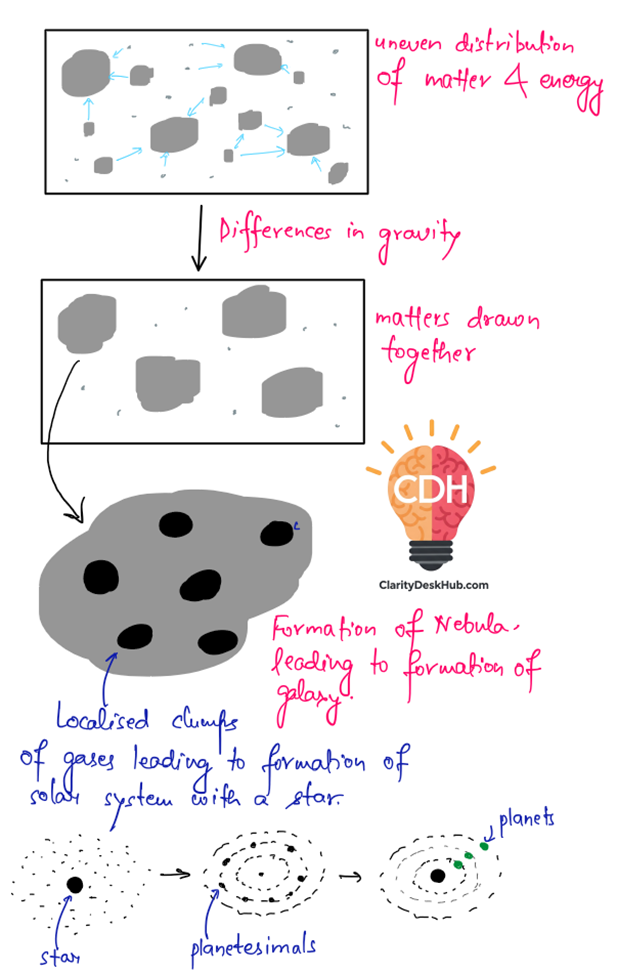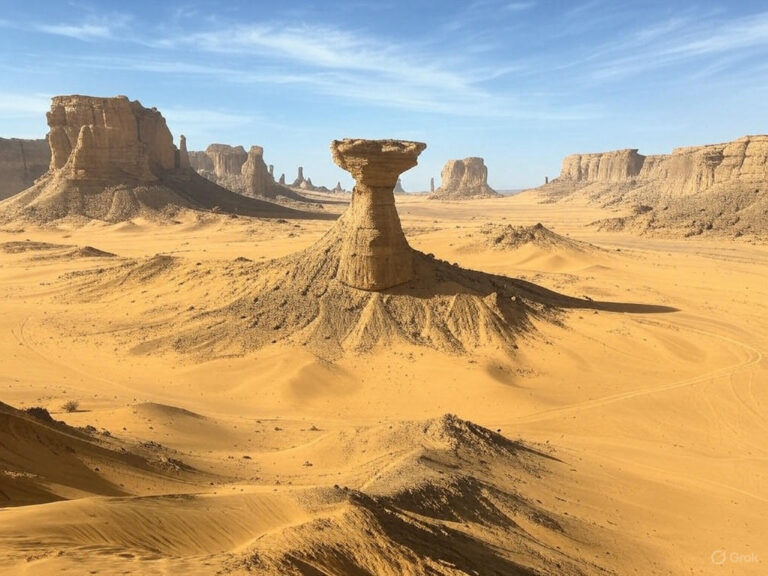Formation of the Solar System
The sky that dazzles us with planets, stars, and galaxies did not always exist in its current form. Over centuries, scientists and philosophers have tried to answer how this solar system came into existence. Let’s understand the major theories, from early philosophical ideas to modern scientific explanations.
🌀 Gaseous Hypothesis — Immanuel Kant
Imagine the early universe as a massive, ancient cloud of gas and dust, quietly rotating in space — this is where Kant begins. He proposed that:
- A primeval cloud made up of dust, vapour, and gas was present.
- Due to mutual gravitational attraction, particles within the cloud collided.
- Collisions generated friction and heat, converting matter into a gaseous form.
- This hot, rotating cloud became a nebula.
- As temperature increased, the nebula spun faster and expanded, forming concentric rings around the centre.
- These rings later condensed into planets.
🧠 Kant’s idea was imaginative but lacked scientific backing about the behavior of gases and the role of angular momentum.
🌀 Nebular Theory — Laplace
Laplace refined Kant’s hypothesis into a more structured scientific theory:
- A gaseous nebula began to cool and contract.
- As it shrank, its rotational speed increased (due to the conservation of angular momentum).
- This caused the equator to bulge and matter to spread outward.
- Eventually, rings of gas separated from the equator due to the increased centrifugal force.
- These rings cooled and condensed into planets, while the remaining central mass became the Sun.
🧠 This theory attempted a more physical explanation, but couldn’t explain how planets achieved their present-day orbits.
🌟 Planetesimal Hypothesis — Chamberlin & Moulton
Now let’s imagine two cosmic bodies: a proto-sun and a passing star.
- As the star came close, its gravitational pull ripped off small pieces from the proto-sun.
- These pieces, called planetesimals, floated in space.
- Gradually, they aggregated and collided, forming the nuclei of planets.
🧠 Although it introduced the idea of external disturbance, it couldn’t justify how a star could come that close without disrupting the whole system.
🌊 Tidal Hypothesis — James Jeans & Harold Jeffrey
Taking Chamberlin’s idea further:
- A near-collision between the proto-sun and an intruding star occurred.
- This gravitational tug-of-war pulled filament-like matter from the sun (like stretching hot toffee).
- This cigar-shaped filament later cooled and fragmented into planets.
🧠 The visual analogy is appealing, but like its predecessor, it couldn’t explain the precise angular momentum distribution among Sun and planets.
🌟 Binary Star Hypothesis — Russell
Russell theorized a scenario with three stars:
- A companion star revolved around the proto-sun.
- A third star approached, collided with the companion star.
- This collision ejected matter, which began orbiting around the proto-sun and later formed the planets.
🧠 Complex and dramatic, but lacked astronomical evidence.
💥 Supernova Hypothesis — Fred Hoyle
A more scientifically grounded idea based on stellar life cycles:
- There were two stars: the primitive sun and a companion star.
- Due to excessive nuclear fusion, the companion star exploded — a supernova.
- The explosion released gaseous matter that formed a rotating disc around the primitive sun.
- This disc material became the raw material for planets.
🧠 This idea brought the role of supernova into planetary formation, linking it with the life and death of stars.
🌌 The Modern Understanding: Big Bang to Solar System
🔭 The Big Bang Theory
- In 1920, Edwin Hubble gave evidence that the universe is expanding.
- The universe began from a single, dense point that exploded — the Big Bang.
- Everything, including galaxies and stars, emerged from this event.
🌀 Nuclear Disc Model / Neo-Laplacian Model
This is the most accepted modern theory for the solar system’s formation.
Timeline:
- Nebular collapse began: ~5 to 5.6 billion years ago.
- Sun and planets formed: ~4.6 billion years ago.
☀️ Formation of the Sun
Let’s understand how:
- A shockwave from a nearby supernova made the nebular cloud unstable.
- It collapsed under its own gravity.
- Matter started coalescing at the centre — this central mass became extremely hot.
- Once temperature was high enough, nuclear fusion started — this gave birth to the Sun.
- 99.9% of the matter formed the Sun; 0.1% remained in a flat rotating disc — the protoplanetary disc.
🪐 Formation of the Planets
Within this solar nebula disc:
- Dust particles collided and stuck together → forming planetesimals.
- These planetesimals grew larger through accretion → became protoplanets.
- In the inner region (hot), rocky planets formed: Mercury, Venus, Earth, Mars.
- In the outer region (cool), icy and gaseous planets formed: Jupiter, Saturn, Uranus, Neptune.
- Leftover rocks became asteroids, especially in the asteroid belt between Mars and Jupiter.
🌍 Iron Catastrophe & Planetary Differentiation
Once Earth formed (~4.5 billion years ago):
- Radioactive decay and primordial heat made Earth hotter.
- Around 500 million years later, temperature crossed 1,538°C — the melting point of iron.
- This caused heavy metals (like iron, nickel) to sink to the core, and lighter materials (silicates, water) to move upward.
- This process is called planetary differentiation.
- The Earth’s core, mantle, and crust were formed due to this.
You can draw the following diagram in the exams to enrich your mains answer writing:

🧭 Conclusion
Each theory — from Kant to Hoyle — tried to explain a cosmic mystery. Some were imaginative, some partially scientific. But the modern nuclear disc model, backed by astrophysics and observational data, gives us the most coherent picture of how stars and planets formed from stardust.
As UPSC aspirants, understand the evolution of scientific ideas, not just the final answer. This will help you tackle both objective and analytical questions with depth.





One Comment